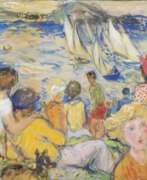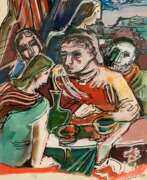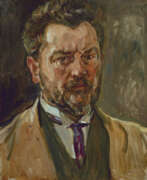Illustrators Berlin Secession
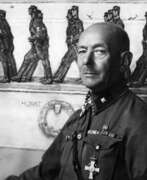

Ludwig Julius Christian Dettmann was a German artist of the late 19th century and the first half of the 20th century. He is known as one of the leading representatives of the Secession in Germany.
Dettmann began his career as an illustrator and in 1895 became a professor at the Berlin Academy of Arts. He then switched to landscape painting, worked in oil and watercolor techniques and became one of the first Impressionists in Germany. In 1898 the artist joined the Association of German Free Artists and co-founded the Berlin Secession. In 1900 Dettmann became director of the Königsberg Academy of Arts and promoted the development of the Nida colony of landscape artists on the Curonian Spit.
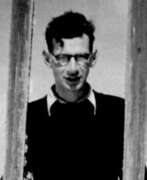

Rudolf Grossmann (German: Rudolf Grossmann, or Großmann), full name Rudolf Wilhelm Walther Grossmann, was a German painter, draftsman, illustrator and graphic artist.
Born into an artistic family, Grossmann began his education in painting and printmaking at the Düsseldorf Academy before continuing his studies in Paris with Lucien Simon and Pouleroz. Among his best-known works are various portrait drawings of celebrities, notably those published in the satirical periodical Simplicissimus; he was also known for his book illustrations. Grossmann began publishing his prints in 1905, and many major publishers in Germany and France commissioned his work. He later concentrated on figurative works and urban scenes, which showed the influence of Cézanne and Pasquin.
From 1928 until Hitler's Nazi Party came to power, Grossmann taught at the Berlin Royal School of Art and was a member of the Berlin Secession and the Deutsche Kunstlerbund. In 1934, his work, like that of many of his colleagues, was stigmatized as degenerate and confiscated by the Nazi government, and he was disbarred from practicing his profession. He soon left for Freiberg im Beisgau, where he died on November 28, 1941.
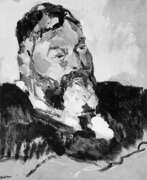

Otto Hettner was a German painter, graphic artist, illustrator and sculptor.
Hettner studied at the Academy of Fine Arts in Karlsruhe with Robert Petzelberger and at the Académie Julian in Paris, then lived in Florence for a year and studied again, this time at the Dresden Academy of Fine Arts. In 1916 he became a member of the executive committee of the Free Secession, and the following year he became director and professor at the Dresden Academy of Fine Arts, where he worked until 1927.
Otto Hettner illustrated various books for well-known publishing houses. After the artist's death, the Nazis, who came to power in Germany, considered Hettner's works degenerate, and in 1937, as part of the campaign "Degenerate Art" 15 of his works were confiscated from museums.
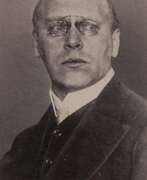

Ludwig von Hofmann is a German painter, graphic artist and designer. The influence of Historicism, Art Nouveau, Symbolism and New Realism can be felt in the works of Ludwig von Hofmann at different periods of his art.
Ludwig von Hoffmann studied painting at the academies of fine arts in Dresden, Karlsruhe and Munich. Since 1898 he was a member of the cultural movement Berlin Secession.
After the National Socialists came to power in Germany, some of his works were classified as degenerate art, but most of them continued to be exhibited in museums in Germany.
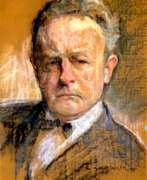

Heinrich Eduard Linde-Walther was a German painter and illustrator. He studied painting at the Academy of Fine Arts in Munich with Gabriel von Hackl and Paul Hoecker. Also at the Académie Julian in Paris. Member of the Berlin Secession since 1902.
Heinrich Eduard Linde-Walter was mainly known for landscapes and still lifes, but also did numerous children's portraits and illustrations for children's stories. Most of his works were commissioned by individual clients and remain in private ownership.


Hans Looschen was a German painter and illustrator.
Looschen received his professional education at the Prussian Academy of Fine Arts, 1893 regularly participated in the Great Berlin Art Exhibition and was its president on several occasions. From 1899 to 1901 he was represented in the Berlin Secession and was also a member of the Berlin Artists' Association.
Hans Looschen painted landscapes and portraits, still lifes and historical paintings in the style of 19th century realism. He also worked as an illustrator. During his lifetime, Loschen received many awards and prizes for his work.


Hans Meid was a German painter, graphic artist and illustrator.
Meid attended an art and craft school in Karlsruhe, and then at the art academy he became a pupil of impressionist Wilhelm Trübner (1851-1917) and realist Walter Kontz (1872-1947). In 1907 the Meissen porcelain manufactory engaged him as a designer; in 1908 he settled in Berlin as a freelance artist. His success was recognized with the Villa Romana Prize (1910) and membership in the Berlin Secession (1911). In 1919 Meid became a lecturer in printmaking at the University of Fine Arts in Berlin. In 1927 he was elected a full member of the Prussian Academy of Fine Arts, where he also headed the graphic arts workshop.
In the first decades of the twentieth century Hans Meid, together with his close friend Max Slevogt, was one of the leaders of Impressionism. He created an extensive collection of etchings, lithographs and engravings, a large number of illustrations for works of world literature, including Cervantes' Don Quixote, Goethe's Selective Affinity and many others. He designed book covers for 44 publishers (notably Schünemann and S. Fischer). He later added ink drawing, watercolor and oil painting. In 1948 Hans Meid became a lecturer at the State Academy of Fine Arts in Stuttgart, he was also a member of the German Artists' Association.


Felix Meseck was a German painter, illustrator and graphic artist.
He studied at the Academies of Fine Arts in Berlin and Königsberg, studying painting with Ludwig Dettmann and etching with Heinrich Wolf. In 1926 he was appointed professor at the Weimar Academy. After World War I, when he served at the front as a private soldier, Meseck took up engraving with success. He was a member of the Berlin Secession, the Association of German Artists, collaborated with leading magazines such as Ganymede, and illustrated works by Shakespeare, Goethe, Novalis, and Brentano.
Unfortunately, most of Felix Meseck's work was destroyed in 1945 during World War II. A frequent motif in Mezek's works is trees, and his techniques were pen drawings and dry needle etchings.


Franz Skarbina was a German painter of the last quarter of the nineteenth and early twentieth centuries. He is known as an Impressionist painter, draughtsman, graphic artist and etching artist.
Franz Scarbina came under the influence of the Impressionists early in his career, in this style he depicted city life, salons, and beach scenes. The artist worked as a teacher at the Berlin Academy of Arts, headed the anatomical drawing department at the school of the Museum of Applied Arts in Berlin. The most fruitful for the master were 1882-1886 years - he, living in Paris, created many works, visited Africa, Belgium and Holland.
Skarbina was one of the founders of the art group and a participant of the Berlin Secession. A street in Berlin is named after him.
